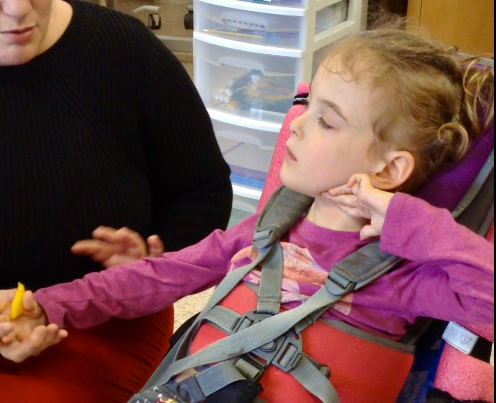Module 2: Movement
Types of Muscle Tone Patterns
Earlier, you learned about how muscles are controlled by the brain. The brain and muscles work together to perform voluntary movements that require complex regulation of muscle tone, posture, balance, and co-ordination. Signals travel down the motor pathway, and information comes back to the brain about where muscles and joints are in space. It’s not about the strength of the muscles themselves, but rather the baseline resting tension provided by brain signals that form this baseline muscle tone.
Normal muscle tone is high enough to resist the effects of gravity, yet low enough to allow freedom of movement. Low muscle tone, high muscle tone, and dyskinetic muscle tone are terms for when muscle tone is outside of this typical range. Muscle tone patterns can be mixed in the same individual. For example, low tone in the trunk, and high muscle tone in the limbs. Muscle tone differences can be very tiring for a person managing everyday tasks. Muscle tone differences can also affect the muscles of the face and neck, interfering with speaking and eating.
| Muscle Tone Pattern | Definition | Description |
|---|---|---|
| Hypotonic | Low muscle tone | Muscles appear loose or floppy |
| Hypertonic | High muscle tone | Muscles appear too stiff and more resistant to quick movement (spasticity) and may include retained primitive reflexes |
| Dyskinetic | Disorganized tone | Umbrella term for disorganized movement
|
| Mixed pattern | Combination of types in one individual | |
Low Muscle Tone
When there is not enough resting tension, muscles appear loose and floppy like a slack elastic band. A student with low muscle tone may have difficulty maintaining their posture to sit in a chair without extra support. Low muscle tone is also commonly part of many genetic syndromes.
Watch the following video and notice how this student with low muscle tone needs assistance to get into the chair. Think about how much work it is, and how much extra time it takes to get into the chair. What might the student be missing out on in the classroom while working on this task?
High Muscle Tone

When there is too much resting tension, muscles appear overactive or stiff like a tightly stretched elastic band. Students with high muscle tone may have difficulty fully straightening out their arms and opening their hands to reach for objects or may have stiffness in their legs impacting standing or walking.
With high muscle tone, primitive reflexes that typically disappear by a few months of age may be retained. Remember the Asymmetrical Tonic Neck Reflex (ATNR) in the typically developing infant? This reflex causes the limbs to move in an involuntary pattern when the head is turned to the side.
In this image, a student is trying to look and reach at the same time, and this retained reflex is limiting her success.
Watch the video below of a student driving a power wheelchair to get around their secondary school. How does their high muscle tone make it challenging and time-consuming for to feed themself with a spoon, even with the support of an adult? What might they be missing out on at lunchtime with their classmates?
Dyskinetic Muscle Tone
If there is an injury or developmental difference in the parts of the brain that control balance, posture, or co-ordination, disorganized movement may result. This can make everyday tasks very challenging. Dyskinetic movement is an umbrella term including:
- Athetosis: fluctuating muscle tone
- Dystonia: involuntary muscle contraction
- Ataxia: balance and co-ordination difficulty
Watch the following videos. This student is completing a worksheet in the classroom. Notice the involuntary dystonic movements that make this task challenging and tiring.